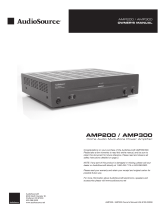
AMP100VS
OWNER’S MANUAL
13970 SW 72nd Ave, Portland, OR 97223 • 503.914.4688 • www.audiosource.net
3
1. Power Switch
Switches the AMP100VS on or off. A red LED indicates connection to AC
power while in standby mode. Turns green indicating audio signal is present.
2. Speaker Selector
Selects speaker zone A or B. For A + B zones push both buttons in.
3. Balance
Fades speaker output between the Right and Left Channels
4. Volume
Adjusts amplifier volume.
FRONT PANEL CONTROLS
7. Interupting Line Input
This is the secondary input, use MAIN IN for your main input.
INTERRUPTING INPUT can be used if a second source is desired and
takes over when signal is present and has at least a 5mV level.
When there is no signal, or a signal with less than 5mV level, the amp
switches back to MAIN IN after a brief delay.
8.
10.
Main Input/Output
11.
12.
Mode Select Switch
Switches the amplifier from Stereo mode to Bridged mode.
13.
15.
AUTO ON Select Switch
Power can be turned on and off manually via the switch on the front panel
or automatically by signal sensing. Set it to NORMAL for manual power on/off.
Set to AUTO for signal sensing; the amp will turn on when audio signal is
detected at the inputs. NOTE: The front panel power switch must be in the
ON position (pushed in) for the AUTO ON feature to operate.
Speaker Zone A Output
Speaker output terminals for zone A. Minimum impedance: 8 ohm bridged
or 4 ohm stereo.
Speaker Zone B Output
Speaker output terminals for zone B. Minimum impedance: 8 ohm bridged
or 4 ohm stereo.
Power Cord & Fuse Holder
This amplifier is configured for operation at 117V (North America). A fuse
in the integrated holder provides safety protection from fault conditions.
Replace fuse with 5 x 20mm T4A 250V.
REAR PANEL CONTROLS
Figure 1. Front Panel
4
3
2
1
6
9
11 13
Figure 2. Rear Panel
Connect
Receiver
Here
12
MAIN IN should be used as the “primary” or main input for the amplifier.
Connect your receiver or main source to this input. Use MAIN OUT to pass
MAIN IN signal to another amplifier.
If you will be connecting one or two pair of speakers to the amplifier, place
the switch in the “Stereo” position. NOTE: For playing 2 pairs of speakers
(A plus B), make sure each speaker has an impedance of 8 ohms or greater.
When set to “Bridged” mode, the amplifier is a single channel mono amplifier.
NOTE: The AMP100VS supplies 150W in bridged mode, Please verify that your
speakers are capable of handling such power to avoid possible damage!
For stereo output connect the speaker’s positive (red) terminal to the amplifier’s
positive (red) terminal, and the speaker’s negative (black) terminal to the
amplifier’s negative (black) terminal for each Right and Left speaker.
NOTE: To prevent sonic degradation in your speaker installation, total speaker
wire resistance should be kept below 0.5 ohms. This table lists recommended
speaker wire gauge versus wire run length.
Place the “MODE” switch in the “BRIDGED” position and use both red
terminals to connect to the speaker. Connect the speaker’s positive (red)
terminal to the amplifier’s red (+) terminal noted next to the bridging mark, and
the speaker’s negative (black) terminal to the amplifier’s unmarked positive
NOTE: Only one zone (A or B) can be bridged. Do not attempt to bridge both
A and B speaker terminals! This may result in a lower impedance than the
amplifier is designed for and may damage your amplifier. The minimum
impedance for the total load connected in bridged mode is 8 ohms.
STEREO MODE
BRIDGED MODE
BRIDGED MODE- MONO APPLICATION
For bridged mode, playing Right and Left together as mono output, use a
Y cable adapter to connect Right and Left RCA signal to the Right (Red) input
at MAIN IN. Set the MODE switch to BRIDGED and follow the instructions
for bridged speaker connection in the SPEAKER TERMINALS section of
this manual.
50’ or less - 16 Gauge 2-Cond. CL3 Rated
50’ - 150’ - 12 Gauge 2-Cond. CL3 Rated
150’ - 200’ - 10 Gauge 2-Cond. CL3 Rated
SPEAKER TERMINALS - STEREO MODE
SPEAKER TERMINALS - BRIDGED MODE
6. Bass and Treble Controls
These controls can adjust bass and treble frequencies +/- 12dB at 100Hz
and 10kHz.
7
9. 12V Trigger
Allows the AMP100VS to be powered on by other electronics or to power
on other electronics via a 3.5mm mini phone plug cable.
10
8
(red) terminal.
NOTE: Use Class 2 wiring for speaker connections.
To wire the output connector: 1. Strip the insulation off each speaker wire to expose 3/8"
(10 mm) of bare conductor. 2. Unscrew the output terminal binding post several twists,
insert each wire into the correct terminal. 3. Tighten binding post by twisting clock-wise
until it is firmly clamping the speaker wire.
Warning: While the amplifier does self-protect under most improper output conditions,
misconfiguration of loudspeaker mode and incorrect connection of loudspeakers could
damage connected loudspeakers and/or amplifier.
Please refer installation to a qualified installation professional, and always check state and
local electrical codes when installing.
14. Unswitched A/C Terminal
Provides A/C power for additional components. Use only for a single low
power device such as a tuner, CD, DVD, turntable or other non-amplified
electronics. Do not connect another amplifier or receiver. Ensure 400W
max power connumption for any device plugged in here.
14
15







